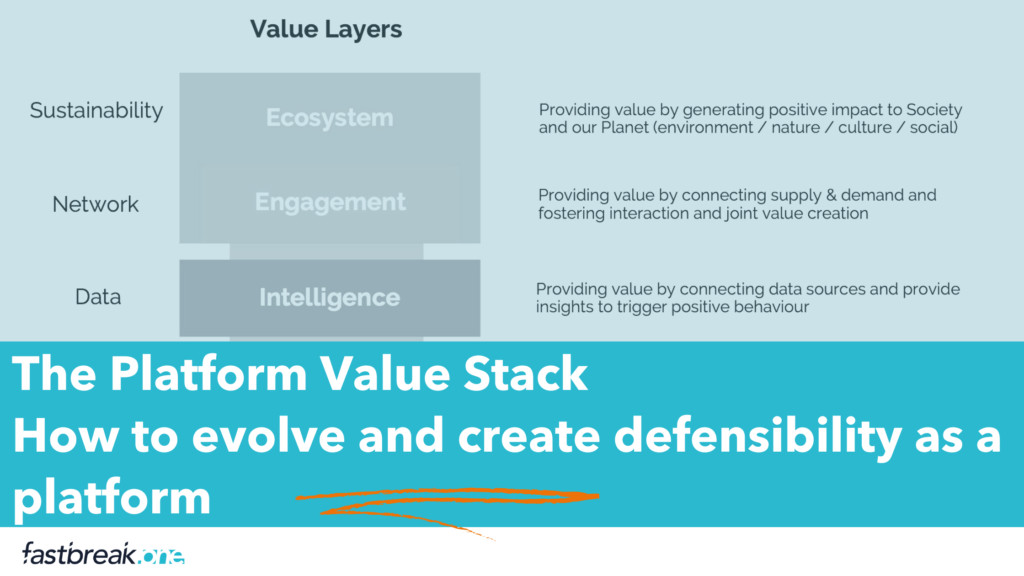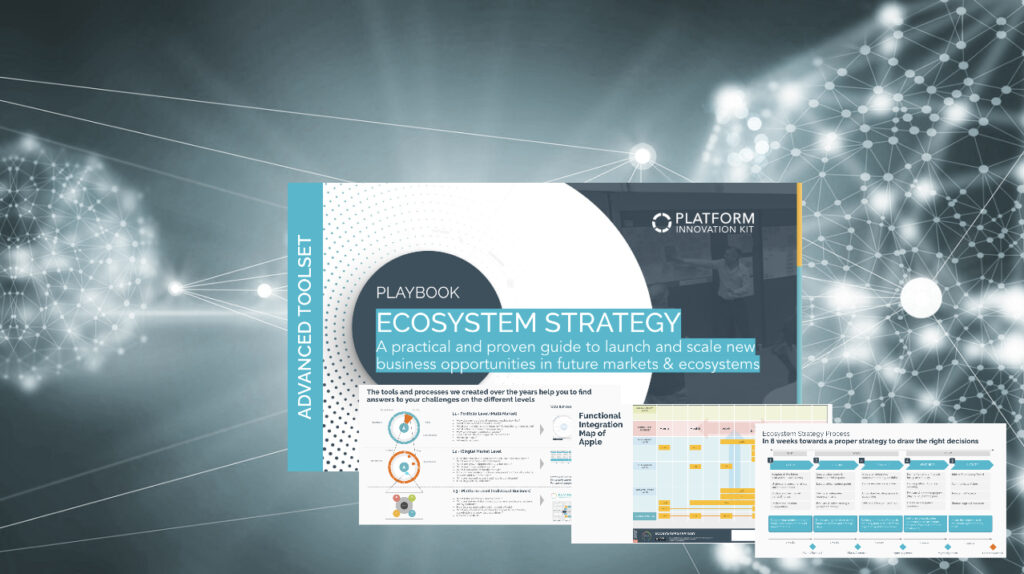Latest Insights

In the dynamic and rapidly evolving landscape of the digital economy, platforms have emerged as dominant actors, reshaping industries and redefining competitive dynamics. Drawing from an extensive analysis of over 400 platform cases, We’ve distilled the essence of what makes some platforms not just survive but thrive. The conceptual framework, which we call the “Platform Value Stack,” is pivotal for understanding the architecture of successful platforms. The stack comprises four critical layers: Sustainability, Engagement, Intelligence, and Infrastructure. Using Amazon as a case study, we’ll explore how platforms evolve through these layers, building defensibility and securing market leadership.
Research Results
We looked especially on B2B platforms in Europe and how they evolve over the time. Based on the sample size of 400 platforms we found out, that basically they provide value to the users on 4 major layers. Some of the platforms – the most successful ones – are providing value on multiple layers.
Interesting wise, the platform businesses developed top-down or bottom-up following the layers of the Platform Value Stack.
The Platform Value Stack
Confirmed by the research, we updated our initial Platform Value Stack model with the 4 key important layers.
1. Ecosystem / Sustainability
2. Engagement
3. Intelligence
4. Infrastructure
1. Sustainability
Sustainability, the foundational layer of the Platform Value Stack, pertains to the economic viability and long-term growth prospects of a platform. It involves establishing a business model that balances value creation with value capture, ensuring the platform can sustain itself financially over time. For platforms, sustainability often hinges on network effects, where the value of the platform increases with each additional user, creating a self-reinforcing loop of growth and value creation.
2. Engagement
The second layer, Engagement, is where platforms like Amazon began their journey. Engagement focuses on attracting and retaining users by offering compelling value propositions. For Amazon, this started with the marketplace—a platform to connect buyers with sellers, offering unparalleled selection and convenience. Engagement is about creating a vibrant ecosystem where users find value in interactions, thereby increasing their commitment to the platform. Features like reviews, recommendations, and personalized experiences enhance engagement, turning the platform into an indispensable part of users’ daily lives.
3. Intelligence
As platforms mature, they ascend to the Intelligence layer, leveraging data and AI to refine operations, personalize offerings, and innovate. Amazon’s foray into artificial intelligence with Alexa and its sophisticated data analytics are prime examples of building capabilities at this layer. Intelligence allows platforms to anticipate user needs, optimize their ecosystems, and create new opportunities for value creation. It’s about harnessing the power of data to drive growth, efficiency, and innovation.
4. Infrastructure
The uppermost layer, Infrastructure, involves building the underlying systems and capabilities that support the platform’s operations and scale. Amazon’s development of its logistics network epitomizes this layer. By investing in infrastructure, platforms can ensure reliability, reduce costs, and enhance the user experience. This layer is critical for sustaining growth, as it allows platforms to control more of their value chain and deliver consistent, high-quality experiences.
Amazon – a perfect example (top-down)
Looking at Amazon, the PVS helps you to understand how the company evolved over the time and build so strong capabilities, that it is almost impossible to imagine how they can be removed from the market.
Amazon started on the Engagement Layer as a simple market place for books and later products. As a 2nd step they added “intelligence” value propositions like recommendation engines or AI driven services like Alexa.
As a 3rd step they invested on the “Infrastructure” layer by building cloud infrastructure services (AWS) or logistics to provide “same day delivery” services.
Answering strategic questions using the PVS
In the graphic below you can see, that the PVS helps you to answer strategic questions regarding your evolution, monetization or resources.
The Platform Value Stack Canvas
As part of the www.platforminnovationkit.com toolset, a toolkit we started to build in 2013, is the Platform Value Stack Canvas. A simple tool you could use in workshops to discuss strategic decisions.
Building Defensibility through the Platform Value Stack
Amazon’s journey through the Platform Value Stack illustrates how platforms can build strong market positioning. Starting with engaging users on a vibrant marketplace, Amazon leveraged data and AI to enhance its intelligence, understanding user preferences and streamlining operations. By building its logistics infrastructure, Amazon not only improved delivery times and costs but also set a new standard for e-commerce, making it difficult for new entrants to compete.
The Platform Value Stack is a blueprint for platforms aiming to achieve lasting success. It underscores the importance of building a sustainable business model, engaging users deeply, leveraging data for intelligence, and investing in infrastructure to support growth. Platforms that systematically evolve through these layers can create significant barriers to entry, locking in users and partners, and securing their position in the market.
In the ever-changing platform economy, understanding and applying the principles of the Platform Value Stack is essential for those looking to build or invest in the next generation of digital platforms. By focusing on these foundational layers, platforms can navigate the complexities of the digital economy, driving innovation, and delivering value to users, partners, and shareholders alike.
Below you will find further insights from our work with organizations around the globe to launch and scale businesses based on network effects and a positive impact to our society.
Business Building
B2B Platforms
Toolkits & Frameworks
Please share & subscribe
If you like our articles, please share in your social media and subscribe to our bi-weekly newsletter.








